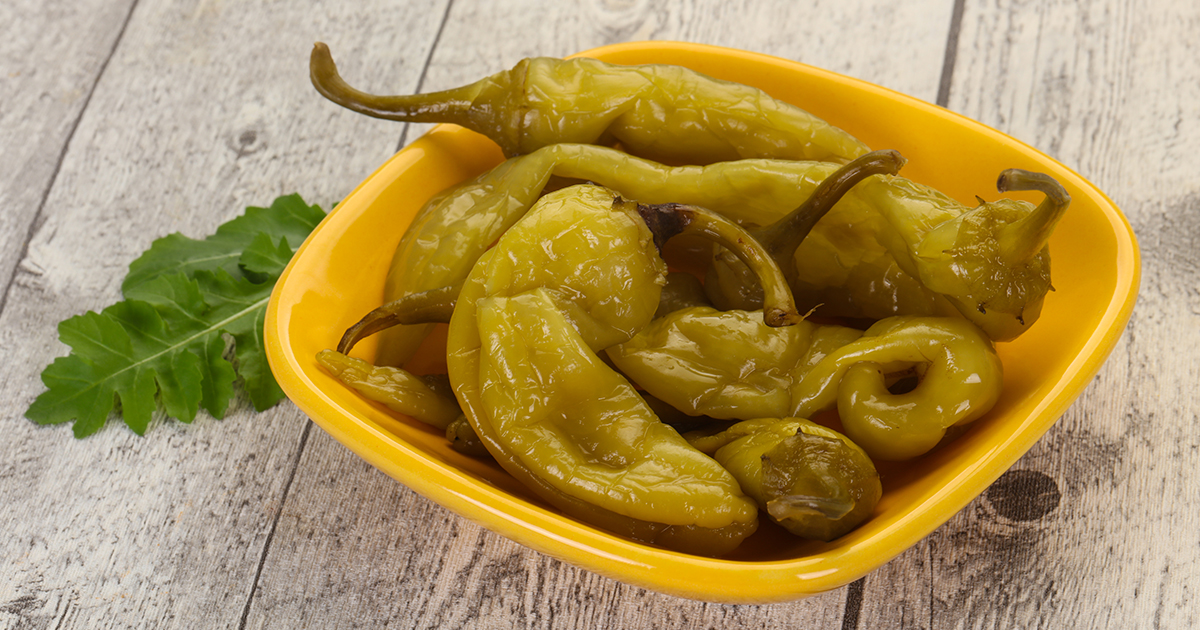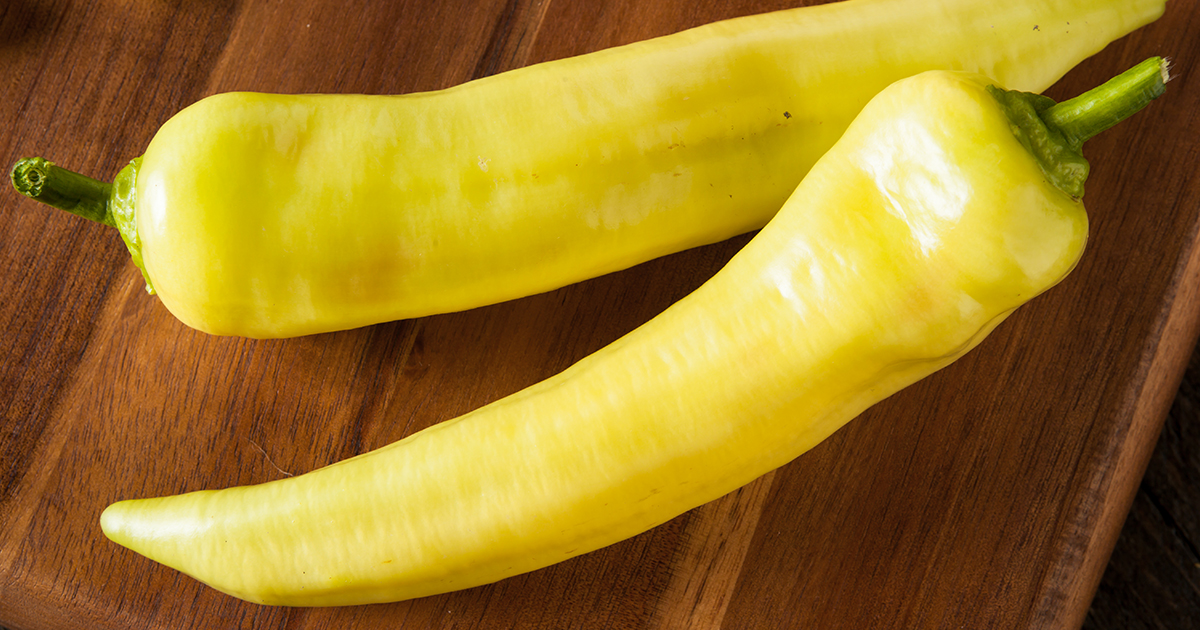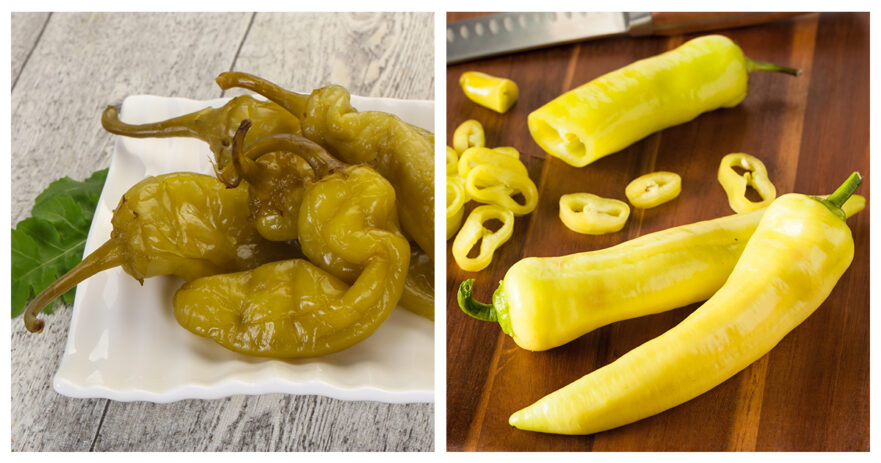Spices and herbs are the unsung heroes of the kitchen. Not only do they bring an exciting new flavor and aroma to our meals, but they also provide some cool health benefits. If you happen to be someone who likes a mild kick, you’re probably familiar with pepperoncini and banana peppers.
While they might look alike, especially when they’ve been pickled, these are two distinct types of peppers with their own flavors and benefits. We’re going to be telling you all you need to know about both of them today. So, let’s get started and spice things up!
| Pepperoncini pepper | Banana pepper | |
| SHU | 100 - 500 | 0 - 500 |
| Median SHU | 300 | 250 |
| Flavor | Mildly sweet and tangy, with a slight heat | Sweet and tangy, with a mild heat |
| Species | Capsicum annuum | Capsicum annuum |
| Origin | Italy | South America (believed) |
| Uses | Pickling, salads, sandwiches, antipasto, etc. | Pickling, stuffing, roasting, grilling, salads, etc. |
Table of contents
What is a Pepperoncini?

The pepperoncini is a small but mighty pepper that’s been a favorite ingredient in Mediterranean cuisine for, well, ever! This sweet and tangy chili pepper is native to Italy and Greece and belongs to the same species as bell peppers, jalapeños, and cayenne peppers. You’ll find it in a wide range of delicious dishes like salads, pizzas, sandwiches, and antipasti.
These peppers are usually around 2-3 inches long and are often yellow-green in color, though they can turn orange-red if they get too ripe. They’re thin-walled but firm to the touch and have a slightly bitter but tangy taste with a mild heat level that only registers between 100-500 on the Scoville scale. This means they’re nowhere near as spicy as some other peppers, like jalapeños, which makes them a popular choice for those who prefer milder heat with good flavor.
Pepperoncini peppers have a hearty texture ideal for pickling, which is how you’ll most often find them sold in stores. These pickled peppers are a common addition to all kinds of meals. They can be eaten fresh, sautéed, or roasted. Their versatility in the kitchen makes them a great addition to a variety of dishes.
In addition to being delicious, pepperoncini also offer a range of health benefits. These peppers are an excellent source of vitamins A, and C. Vitamin A is great for your eyes. Vitamin C is a known antioxidant that can help support your immune system and improve your collagen production. These peppers also contain capsaicin, a natural compound that’s been shown to have anti-inflammatory and pain-relieving properties.
What is a Banana Pepper?

Banana peppers are a variety of mild chili pepper that originated in South America. They can now be widely found in both North American and European cuisines. Named for their long, curved shape that resembles a banana, they’re usually 2-3 inches long but can reach up to 6 inches. These peppers have a vibrant yellow color and firm skin when perfectly ripe, but they can also turn green, red, or orange as they continue to ripen.
Banana peppers have a mild to moderate level of heat, somewhere between 0 and 500 on the Scoville scale. This puts them roughly in the same spice category as pepperoncini, making them a safe choice for those who prefer milder spices. They’re well-known for their sweet and tangy flavor.
These peppers are great for all sorts of dishes, like salads, snack boards, and salsas. You can often find them as a pizza topping, where their mild heat and sweet flavor can balance the richness of other toppings. Banana peppers are also popularly pickled, where they’re used to add tang and crunch to dishes.
Along with their yummy flavor, banana peppers are also chock-full of health benefits. They’re rich in vitamin C, which is an essential nutrient for a healthy immune system and for reducing inflammation in the body. They also contain capsaicin, the same natural compound found in other chili peppers, which is shown to have anti-inflammatory and pain-relieving properties.
What are the similarities between Pepperoncini and Banana peppers?
If you’re a fan of mild, sweet, and tangy peppers, you’ve almost certainly come across pepperoncini and banana peppers. These sweet little snacks are popular across many of the same regional cuisines. While they are different, these two peppers happen to share many similarities in taste, appearance, and culinary uses.
Let’s talk appearance. Both pepperoncini and banana peppers belong to the Capsicum annuum family, the same as bell peppers, jalapeños, and cayenne peppers. They’re both small to medium-sized peppers, usually between 2-3 inches long, and can vary in color from bright green to yellow, orange, and red. When mature, they’re firm to the touch and have a slightly sweet yet bitter taste and a mild heat level that can register between 100-500 on the Scoville scale.
In the kitchen, pepperoncini and banana peppers are incredibly versatile and can be used in a wide range of dishes. They can be pickled, sautéed, roasted, or used fresh in pizzas, sandwiches, soups, and more. Their sweet, tangy flavor is a great addition to all sorts of recipes, and their mild heat level makes them a popular choice for those who want a little extra flavor without too much spice.
In addition to their culinary uses, both of these peppers also offer up a range of health benefits for you. They’re both fantastic sources of vitamin C, which is a powerful antioxidant as well as important for skin health. They both provide other vitamins and capsaicin, as well.
Whether you’re more of a fan of pepperoncini or banana peppers, these little guys share many similarities, and both are delicious and versatile ingredients that offer plenty of uses in the kitchen.
What are the differences between Pepperoncinis and Banana peppers?
While pepperoncini and banana peppers may look similar at first glance, they’ve got some key differences that set them apart.
One of the most significant differences is their heat level. Pepperoncini peppers are generally considered mild-medium, with a heat level ranging between 100-500 on the Scoville scale, with the average heat level being around 100-300 SHU. Some banana peppers have a heat level of 0 on the Scoville scale, while others can reach up to 500 SHU, with the typical heat level being around 0-300 SHU. If you’re looking for a milder option, the banana pepper is a safer choice. If you’re seeking a bit of heat, pepperoncini might be the way to go. Ultimately, the decision between these two peppers will depend on your personal preference for heat.
Getting into their looks, pepperoncini peppers are typically smaller, ranging from 2-3 inches long. They have thin, more wrinkly skin. On the other hand, banana peppers are longer and curved with thicker, smooth skin. They can range from 2-3 inches up to 6 inches in length. To differentiate between the two, you can look at their skin – pepperoncini have more wrinkled skin compared to the smoother banana pepper. Additionally, the banana pepper will have a more pointed tip, resembling a banana, while the pepperoncini end is more rounded. You can also tell the difference when you cut into the peppers, as a banana pepper will have thicker inner skin walls while the pepperoncini skin will be thinner.
When it comes to their flavors, pepperoncini peppers have a slightly bitter aftertaste with a tangy, sweet flavor up front. Banana peppers have a milder taste that’s often described as slightly sweet with a hint of spice. This difference in flavor might sound minimal, but it can make one pepper a better choice than the other, depending on the recipe and personal preference.
Both peppers are often used in Mediterranean and Italian cuisine, but they tend to be used a bit differently. Pepperoncini peppers are more commonly used pickled, while banana peppers are often used in fresh foods. Also, if you’re looking for the better stuffed pepper, you’ll want to go with the banana pepper due to its thicker skin.
As you can see, both peppers offer unique flavors and health benefits, and they have distinct differences that make them better suited for different recipes and personal preferences. Whenever you’re looking to add a light kick to your favorite dish, both pepperoncini and banana peppers are great options to try. See which one tickles your tastebuds more!
FAQ about Pepperoncini and Banana peppers
Are pepperoncini and banana peppers the same thing?
Nope, they're two distinct types of peppers. While they do share similarities in taste, appearance, and food uses, they have different origins, shapes, and heat levels.
Which one is hotter, pepperoncini or banana pepper?
Both peppers have a mild heat level that registers between 0-500 on the Scoville scale. However, that varies depending on the variety, growing conditions, and maturity of the pepper. Just remember that the hottest of each will be the same level, but the mildest of pepperoncini will outrank the mildest banana pepper.
Can I use pepperoncini and banana peppers interchangeably in recipes?
You can totally use them interchangeably in recipes that call for mild, sweet peppers! However, keep in mind that their taste and texture may differ slightly, so adjust the amount and preparation method accordingly.
Can I grow pepperoncini and banana peppers at home?
Both peppers are definitely easy to grow in containers or gardens as long as you provide them with enough sunlight, water, and nutrients. You can find seeds or seedlings at garden centers or online stores.
Are pepperoncini and banana peppers good for you?
Absolutely! Both peppers are low in calories and high in nutrients, including vitamins and antioxidants, which are important for a balanced and healthy diet. While there's definitely evidence to suggest that certain components in these peppers may have potential health benefits, it's important to note that more research is still needed to fully understand their effects on human health. As with any food, it's important to eat them in moderation, especially if you have a sensitive stomach or a history of digestive issues.
